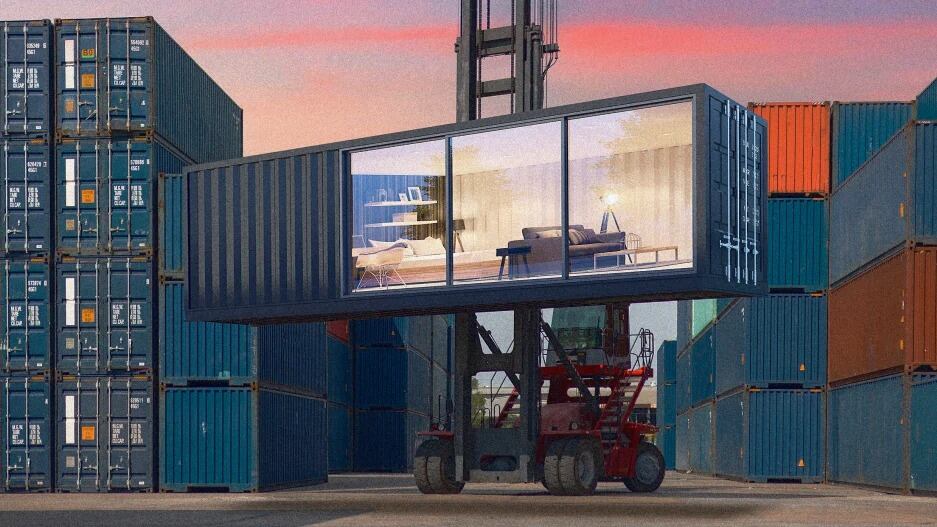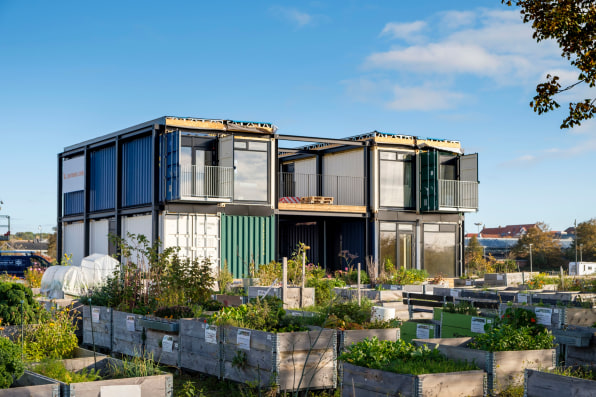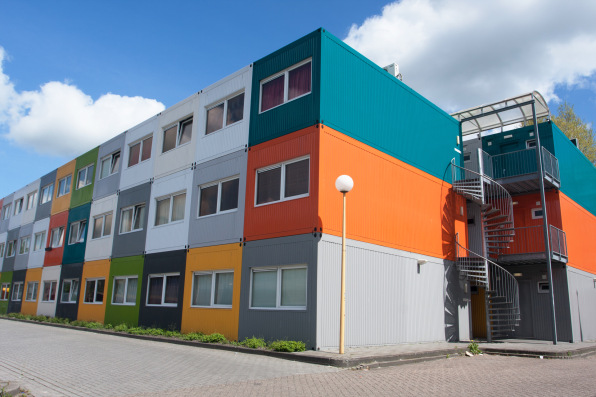- | 9:00 am
All those tiny homes made from shipping containers aren’t as sustainable as you think. Here’s why
Shipping containers are beloved for their aesthetic appeal and supposed sustainability. But the reality is a bit more complicated.

In recent years, shipping containers have become a trendy building material around the world, used for everything from pop-up shops to hotels. They’re seen as a way to extend the life of a container that would otherwise be discarded, and an eco-friendly alternative to manufacturing new materials. More popularly, they’ve been touted as viable structures for sustainable housing, particularly with the rise of the tiny house movement and housing shortages around the world.

This trend may see an even bigger upswing, as millions of extra shipping containers were produced during the pandemic—a desperate attempt to alleviate supply chain issues. Due to empty containers not arriving back to their point of origin on time, as many as 4.3 million extra containers were manufactured. Many of these are no longer needed, and the excess containers have been left in ports across the U.S., including the Port of Savannah, which at one point had 30 ships anchored waiting to unload thousands of containers the port didn’t have space for.
Considering the growing popularity of containers-as-infrastructure, converting these excess containers into homes or offices is likely to be an attractive possibility. However, experts say their sustainability is better on paper than in practice, and those interested in converting shipping containers should take a closer look before deciding whether homes are the best use for them. Complicated conversions, extensive labor, and more materials can often mean these reclaimed spaces are much less practical—and less sustainable—than initially envisioned.

Throughout the world, containers are already being used for commercial and community spaces. In Turin, Italy, shipping containers were repurposed into COVID-19 intensive care units, and in London, they were used to construct the Stow Away Hotel. In the U.S., they’ve been used to build everything from tiny backyard homes to apartment buildings. The global container home market is expected to grow from $46.63 billion in 2021 to $67.96 billion in 2026, according to a report from the Business Research Company.
But many people who convert containers to homes prefer to use a new container or one that’s only been used for a single trip. Because shipping containers are largely manufactured in China, it’s quite costly to order a new one and have it shipped to the U.S. Therefore, many buyers will lease their container to a shipping company for one trip to save on costs (which, of course, does nothing to alleviate the excess supply or give them a second life). On top of that, the size constraints make them difficult to convert. The largest shipping container available measures 305 square feet; that means for all but the tiniest houses, multiple containers will likely need to be used.
When it comes to securing these containers, they can be bought secondhand for under $1,000 each, depending on the condition. They can also be bought directly from wholesalers, with new containers costing around $4,000 to $5,000 apiece

Meanwhile, retrofitting the containers to create a home can cost anywhere from $20,000 to $150,000, depending on whether it’s DIY or a company is paid to convert. Either way, it requires an extensive overhaul. For this reason, architect Alex Gore of F9 Productions believes shipping container homes will always be a small portion of the housing market. “There are still many alterations that need to be made in order for [them] to be habitable. You need to frame out the walls, floors, and ceilings in order to run electrical and plumbing lines, as well as insulate.”
In his paper Lifecycle Assessment of Shipping Container Homes: A Sustainable Construction, Hamidul Islam notes that these conversions can be made with eco-friendly materials. But this requires owners or architects to be committed to more sustainable methods. Spray foam, for example, is one of the most popular ways to insulate these homes, but can release chemicals while it’s being applied and cause health issues. On top of that, all the standard materials that go inside a home, such as toilets, pipes, and steel framings, release emissions in their production. Although there are more eco-friendly alternatives, these aren’t yet commonly used.
Containers might be better suited to commercial spaces like kiosks and pop-up cafés, according to Jennifer Crawford, architect at Our New Home Coach. For these uses, containers can still have an aesthetic appeal, but are both cheaper and easier to convert, as they likely only require a kitchen and seating area and can be maintained as one space.
Aside from considering how to make shipping containers work for human usage, the most sustainable thing to do with them might just be to recycle them. Gore estimates a shipping container home can remain standing from 50 to 100 years, whereas at sea, a shipping container will survive around 15 years before needing to be retired. However, once the container is turned into a home—with plumbing, insulation, and other retrofits—it can’t be recycled. Whereas raw shipping containers, which are made of steel, are fully—and endlessly—recyclable. Ultimately, removing containers from the circular economy by retrofitting them into usable spaces could put a strain on the industry and result in the need to use more iron ore, causing even more harm to the environment.
Even as the tiny house movement continues to gain popularity and shipping containers are beloved both for their aesthetic appeal and supposed sustainability, it’s worth asking if they’re the right material for this purpose. “Containers are scaled to house goods, not people,” Gore says. “Their proportions make it hard to accommodate human activities.”








































